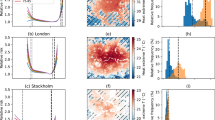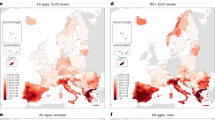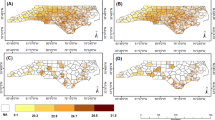Abstract
Background
Studies exploring the racial/ethnicity disparity of the impact of heat on hospital admission are notably limited, especially in Texas, a state with a diverse population and consistently ranking among the top ten U.S. states for heat-related deaths per capita from 2018 to 2020.
Objective
Our objective is to determine the correlation between elevated temperatures and emergency hospital admissions for various causes and age groups across 12 Metropolitan Statistical Areas(MSAs) in Texas. Additionally, we aim to investigate health inequalities in the five largest MSAs in Texas between 2004 and 2013.
Methods
We used MSA-level hospital admission and weather data to estimate the relationship between heat and emergency hospital admissions. We applied a Generalized Additive Model and random effects meta-analysis to calculate MSA-specific associations and overall correlation, repeating the analysis for age groups and specific causes of admission. We also investigated health disparities across racial and ethnic groups and performed a sensitivity analysis.
Results
The results showed that a 1 °C increase in temperature was associated with a 0.50% (95% CI [0.38%, 0.63%]) increase in all-cause emergency hospital admissions. Heat’s impact on hospital admissions varied among age groups and causes, with children under 6 years showing the highest effect estimate (0.64% (95% CI [0.32%,0.96%])). Statistically significant associations were found for Cardiovascular Diseases (0.27% (95% CI [0.07%,0.47%])), Ischemic Heart Diseases (0.53% (95% CI [0.15%,0.92%])), Pneumonia (0.70% (95% CI [0.25%,1.16%])), and Respiratory Diseases (0.67% (95% CI [0.18%,1.17%])). Health disparities were found among racial and ethnic groups in the five largest MSAs.
Impact statement
Studies exploring the impact of heat on hospital admission in Texas are notably limited. Our research provided a comprehensive examination of the connection between heat and emergency hospital admissions throughout Texas. Furthermore, we are the first to examine racial/ethnic disparities, identifying African American and Hispanic groups as disproportionately affected. These insights provide valuable insights for policymakers to allocate resources and implement strategies to mitigate the negative consequences of rising temperatures.
This is a preview of subscription content, access via your institution
Access options
Subscribe to this journal
Receive 6 print issues and online access
$259.00 per year
only $43.17 per issue
Buy this article
- Purchase on Springer Link
- Instant access to full article PDF
Prices may be subject to local taxes which are calculated during checkout





Similar content being viewed by others
Data availability
Hospital admission dataset can be requested through Texas Department of State Health Service.
References
Schramm PJ, Vaidyanathan A, Radhakrishnan L, Gates A, Hartnett K, Breysse P. Heat-related emergency department visits during the northwestern heat wave—United States June 2021. Morb Mortal Wkly Rep. 2021;70:1020.
Ye X, Wolff R, Yu W, Vaneckova P, Pan X, Tong S. Ambient temperature and morbidity: a review of epidemiological evidence. Environ Health Perspect. 2012;120:19–28.
Zhang K, Chen T-H, Begley CE. Impact of the 2011 heat wave on mortality and emergency department visits in Houston, Texas. Environ Health. 2015;14:1–7.
Michelozzi P, Accetta G, De Sario M, D’Ippoliti D, Marino C, Baccini M, Biggeri A, Anderson HR, et al. High temperature and hospitalizations for cardiovascular and respiratory causes in 12 European cities. Am J Respir Crit Care Med. 2009;179:383–9.
Zhang B, Li G, Ma Y, Pan X. Projection of temperature-related mortality due to cardiovascular disease in Beijing under different climate change, population, and adaptation scenarios. Environ Res. 2018;162:152–9.
Anderson GB, Dominici F, Wang Y, McCormack MC, Bell ML, Peng RD. Heat-related emergency hospitalizations for respiratory diseases in the Medicare population. Am J Respir Crit Care Med. 2013;187:1098–103.
Bobb JF, Obermeyer Z, Wang Y, Dominici F. Cause-specific risk of hospital admission related to extreme heat in older adults. Jama. 2014;312:2659–67.
Gronlund CJ, Zanobetti A, Schwartz JD, Wellenius GA, O’Neill MS. Heat, heat waves, and hospital admissions among the elderly in the United States, 1992–2006. Environ Health Perspect. 2014;122:1187–92.
Vaidyanathan A, Malilay J, Schramm P, Saha S. Heat-Related Deaths—United States, 2004–2018. Morb Mortal Wkly Rep. 2020;69:729.
Marsha A, Sain S, Heaton M, Monaghan A, Wilhelmi O. Influences of climatic and population changes on heat-related mortality in Houston, Texas, USA. Clim Change. 2018;146:471–85.
O’lenick CR, Baniassadi A, Michael R, Monaghan A, Boehnert J, Yu X, et al. A case-crossover analysis of indoor heat exposure on mortality and hospitalizations among the elderly in Houston, Texas. Environ Health Perspect. 2020;128:127007.
Seong, K, Jiao, J, & Mandalapu, A. Evaluating the effects of heat vulnerability on heat-related emergency medical service incidents: Lessons from Austin, Texas. Environment and Planning B: Urban Analytics and City Science. 2023;50:776–95.
Li D, Newman GD, Wilson B, Zhang Y, Brown RD. Modeling the relationships between historical redlining, urban heat, and heat-related emergency department visits: an examination of 11 Texas cities. Environment and Planning B: Urban Analytics and City. Science. 2022;49:933–52.
Chien L-C, Guo Y, Zhang K. Spatiotemporal analysis of heat and heat wave effects on elderly mortality in Texas, 2006–2011. Sci Total Environ. 2016;562:845–51.
Texas Demographic Center. 2020 Census Data Release. 2020. https://demographics.texas.gov/data/decennial/2020/, Accessed in May 2023.
Turner A, LaVeist ATA, Richard P, Gaskin DJ. Economic Impacts of Health Disparities in Texas 2020. Episcopal Health Foundation. 2021. https://www.episcopalhealth.org/wp-content/uploads/2021/01/Econ-Impactsof-Health-Disparities-Texas-2020-FINAL-002.pdf, Accessed 1st Jan 2023.
Hansen A, Bi L, Saniotis A, Nitschke M. Vulnerability to extreme heat and climate change: is ethnicity a factor? Glob Health Action. 2013;6:21364.
O’Neill MS, Zanobetti A, Schwartz J. Disparities by race in heat-related mortality in four US cities: the role of air conditioning prevalence. J Urban Health. 2005;82:191–7.
Gronlund CJ. Racial and socioeconomic disparities in heat-related health effects and their mechanisms: a review. Curr Epidemiol Rep. 2014;1:165–73.
Xu Z, Sheffield PE, Su H, Wang X, Bi Y, Tong S. The impact of heat waves on children’s health: a systematic review. Int J Biometeorol. 2014;58:239–47.
Basagaña X, Sartini C, Barrera-Gómez J, Dadvand P, Cunillera J, Ostro B, et al. Heat waves and cause-specific mortality at all ages. Epidemiology. 2011;22:765–72.
Zanobetti A, O'neill MS, Gronlund CJ, Schwartz JD. Summer temperature variability and long-term survival among elderly people with chronic disease. Proc Natl Acad Sci. 2012;109:6608–13.
Chen TH, Li X, Zhao J, Zhang K. Impacts of cold weather on all-cause and cause-specific mortality in Texas, 1990–2011. Environ Pollut. 2017;225:244–51.
Zhang K, Chen Y-H, Schwartz JD, Rood RB, O’Neill MS. Using forecast and observed weather data to assess performance of forecast products in identifying heat waves and estimating heat wave effects on mortality. Environ Health Perspect. 2014;122:912–8.
Coates J, Mar KA, Ojha N, Butler TM. The influence of temperature on ozone production under varying NO x conditions–a modelling study. Atmos Chem Phys. 2016;16:11601–15.
Norval M, Lucas R, Cullen A, De Gruijl F, Longstreth J, Takizawa Y, et al. The human health effects of ozone depletion and interactions with climate change. Photochem Photobiol Sci. 2011;10:199–225.
Reid CE, Snowden JM, Kontgis C, Tager IB. The role of ambient ozone in epidemiologic studies of heat-related mortality. Environ Health Perspect. 2012;120:1627–30.
Sheffield PE, Zhou J, Shmool JLC, Clougherty JE. Ambient ozone exposure and children’s acute asthma in New York City: a case-crossover analysis. Environ Health. 2015;14:1–10.
Bloomer BJ, Stehr JW, Piety CA, Salawitch RJ, Dickerson RR. Observed relationships of ozone air pollution with temperature and emissions. Geophys Res Lett. 2009;36.
Knowlton K, Rotkin-Ellman M, King G, Margolis HG, Smith D, Solomon G, et al. The 2006 California heat wave: impacts on hospitalizations and emergency department visits. Environ Health Perspect. 2009;117:61–7.
Guo C, Lanza K, Li D, Zhou Y, Aunan K, Loo BP, et al. Impact of heat on all-cause and cause-specific mortality: a multi-city study in Texas. Environ Res. 2023;224:115453.
Kenney WL, Craighead DH, Alexander LM. Heat waves, aging, and human cardiovascular health. Med Sci Sports Exerc. 2014;46:1891.
Luong LM, Phung D, Sly PD, Dang TN, Morawska L, Thai PK. Effects of temperature on hospitalisation among pre-school children in Hanoi, Vietnam. Environ Sci Pollut Res. 2019;26:2603–12.
Nitschke M, Tucker GR, Hansen AL, Williams S, Zhang Y, Bi P. Impact of two recent extreme heat episodes on morbidity and mortality in Adelaide, South Australia: a case-series analysis. Environ Health. 2011;10:1–9.
Basu R, Ostro BD. A multicounty analysis identifying the populations vulnerable to mortality associated with high ambient temperature in California. Am J Epidemiol. 2008;168:632–7.
Green RS, Basu R, Malig B, Broadwin R, Kim JJ, Ostro B. The effect of temperature on hospital admissions in nine California counties. Int J Public Health. 2010;55:113–21.
Jung J, Uejio CK, Adeyeye TE, Kintziger KW, Duclos C, Reid K, et al. Using social security number to identify sub-populations vulnerable to the health impacts from extreme heat in Florida, US. Environ Res. 2021;202:111738.
Bernstein AS, Sun S, Weinberger KR, Spangler KR, Sheffield PE, Wellenius GA. Warm season and emergency department visits to US children’s hospitals. Environ Health Perspect. 2022;130:017001.
Anderson BG, Bell ML. Weather-related mortality: how heat, cold, and heat waves affect mortality in the United States. Epidemiology. 2009;20:205.
Anderson GB, Bell ML. Heat waves in the United States: mortality risk during heat waves and effect modification by heat wave characteristics in 43 US communities. Environ Health Perspect. 2011;119:210–8.
Rogot E, Sorlie PD, Backlund E. Air-conditioning and mortality in hot weather. Am J Epidemiol. 1992;136:106–16.
Kuras ER, Richardson MB, Calkins MM, Ebi KL, Hess JJ, Kintziger KW, et al. Opportunities and challenges for personal heat exposure research. Environ Health Perspect. 2017;125:085001.
Oke TR. The energetic basis of the urban heat island. Q J R Meteorol Soc. 1982;108:1–24.
Funding
KZ was partially funded by the American Heart Association grant (19TPA34830085).
Author information
Authors and Affiliations
Contributions
CG: Methodology, Writing – original draft, visualization. KZ: Conceptualization, methodology, supervision, and writing. EG, SL, Yongmei Lu, NPB, NZ, WZ, Yi Lu, YH, JC, and RTE: Writing – review & editing.
Corresponding author
Ethics declarations
Competing interests
The authors declare no competing interests.
Additional information
Publisher’s note Springer Nature remains neutral with regard to jurisdictional claims in published maps and institutional affiliations.
Supplementary information
Rights and permissions
Springer Nature or its licensor (e.g. a society or other partner) holds exclusive rights to this article under a publishing agreement with the author(s) or other rightsholder(s); author self-archiving of the accepted manuscript version of this article is solely governed by the terms of such publishing agreement and applicable law.
About this article
Cite this article
Guo, C., Ge, E., Lee, S. et al. Impact of heat on emergency hospital admission in Texas: geographic and racial/ethnic disparities. J Expo Sci Environ Epidemiol (2023). https://doi.org/10.1038/s41370-023-00590-6
Received:
Revised:
Accepted:
Published:
DOI: https://doi.org/10.1038/s41370-023-00590-6



